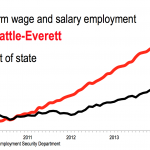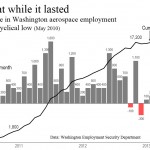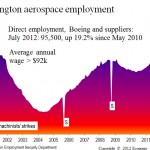A perfect illustration in today’s Seattle Times — and yes, I still read newspapers on dead trees, four a day in fact — how our economy operates today at warp speed. On Page 1, news that in response to competitive pressure from Airbus, Boeing will be cutting costs and trimming [continue reading . . . ]
Overview bullet points ahead of my economic-update presentations last week to the Northwest Wall & Ceiling Bureau (slides here), a trade association, and the Economic Development Association of Skagit County (slides), perhaps Washington’s most successful economic development association: Listen to the music of the global bond markets. The tune they [continue reading . . . ]

Headed for Europe soon? Your timing couldn’t be better. The dollar is up almost 15% against the currencies of major U.S. trading partners in six months, and almost 29% since July 2011. The currencies in question are the euro, the Canadian dollar, the Japanese yen, the United Kingdom pound, the [continue reading . . . ]

The economy of the Seattle area seems as strong as it has been in my 40 years covering the economy as a financial journalist. Amazon’s voracious demand for office space is remaking downtown Seattle and South Lake Union. The pace is breathtaking, and shows no signs of abating. The company [continue reading . . . ]

Beginning in May 2010 and continuing for almost three years, aerospace employers in Washington State added to their payrolls at the rate of nearly 600 a month. Over eight months starting in April 2011, the pace of hiring was almost frantic, averaging about 900 a month, as Boeing scrambled to [continue reading . . . ]
If you worry, as I do, about the future of the aerospace industry and its high-paying in Washington State, you won’t want to miss an excellent roundup of recent developments by Dominic Gates in today’s Seattle Times. Near the end of the long article, a quote from Leeham.net‘s Scott Hamilton [continue reading . . . ]

I’ve just updated Boeing related charts for a presentation on September 13. A couple of things worth noting: Even after adjustment for the loss of Qantas 787 orders last month, Boeing’s backlog in units at the end of August was higher than at the end of March. It hasn’t been [continue reading . . . ]